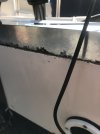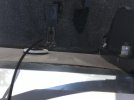I know this subject has probably been beaten to death but I'll risk it. I'm looking at a 2003 grady white sportsman. The boat is in excellent condition but I did notice the bang plate on the transom is eaten away and there is a slight bow, just at the top (see photo). I have thumped the whole transom with a ball peen hammer and I notice no sound differences. The hammer rings back and bounces off as you would expect. Full discloser, this is the first time I've done this. What are folks opinions? is this something I should run away from? is it even worth paying for a survey? There is zero flex on the transom and no stress cracks anywhere in the well. Thanks for any opinions.
Attachments
Last edited:



